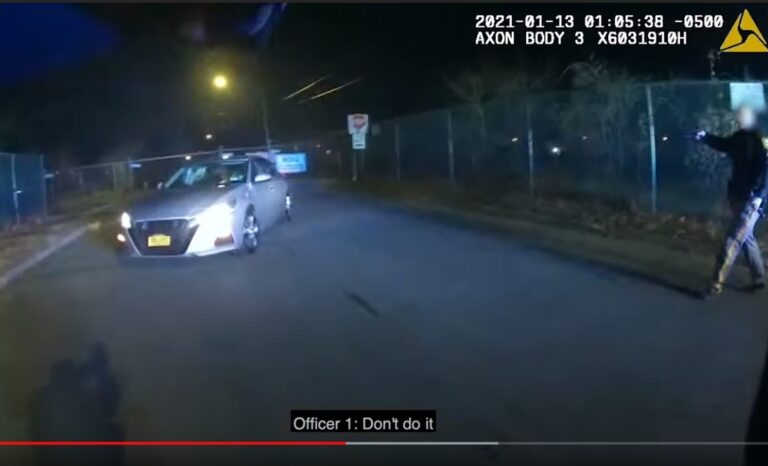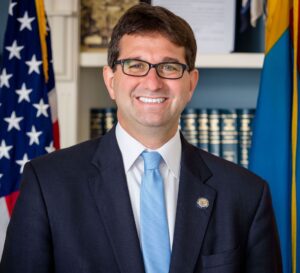Body cam footage of fatal Del. shooting released; slain man’s attorney says it contradicts police account
New Castle County Executive Matt Meyer released the videos over the objections of police. Meyer says transparency is paramount to taxpayers.
Listen 2:05
In a rare move, New Castle County released body-worn camera footage of police shooting and killing of Lymond Moses before the Dept. of Justice completed its investigation into the incident. (Courtesy of New Castle County)
New Castle County Executive Matt Meyer has set a precedent in Delaware by releasing the police body camera footage of the fatal shooting of a Black man while the Department of Justice is still investigating.
The police union had objected to Meyer’s move, saying doing so “taints the investigative process.” Prosecutors are trying to decide whether the two white officers broke state law when they used deadly force against 30-year-old Lymond Moses on Jan. 13.
No Delaware police officer has ever been charged for shooting someone on duty.
Meyer, a Democrat who started his second four-year term days before the Jan. 13 shooting, said he considered the arguments by police but said taxpayers have a right to transparency.
“We all know that in this day and age, the best way to restore confidence in the great work of our women and men [on the police force] is to release the footage,’’ Meyer told WHYY News on Tuesday, one day after making the footage public.

Meyer said making the videos public was “the best way for us as citizens to ultimately control our society, rule our society, to make a determination” about actions by police.
Police have said they shot Moses after he “drove at high rate of speed directly” at them, but the attorney for Moses’ family says the video shows him trying to avoid officers and their vehicles while attempting to escape.
Moses’ family has protested the officers’ actions. They viewed the bodycam footage in February and wanted it released.
The footage from three officers’ body cameras appears to show the officers approach a parked but running car, where Moses was asleep in the driver’s seat.
They reached in and turned the key to off, woke Moses up, and then told him they saw marijuana in plain view. One officer told Moses police “don’t care about weed” but they asked him to get out of the car. Instead, he started the car and drove away.
Police then found Moses’ vehicle stopped at a dead end, where he had made a U-turn. When police arrived, their vehicles were facing his car. He drove toward them and the officers fired several shots. One struck Moses in the head. His car then collided head-on with a police SUV and struck a telephone pole.

Attorney Emeka Igwe, who represents Moses’ sister, widow, and two young children, says the footage contradicts the police account.
“What the video shows is that the officers were not in imminent danger. They were not within the zone of danger,’’ Igwe told WHYY.
“In fact, Mr. Moses actually goes out of his way to swerve away from the officers. And the officers decided to be the judge, jury, and executioner and give Mr. Moses the death penalty for attempting to flee.”
Igwe said the two officers, who are on paid administrative leave, should be charged criminally.
County police spokesman Lt. Brian Faulkner said the department would not comment on Igwe’s assertions “until the ongoing investigation is complete. I can only reaffirm that the results of the investigations, and solely those results, ultimately determine if the officers were justified and acting within the bounds of law.”
‘Providing this video can help fill in the gaps’
Delaware law prohibits authorities from charging a police officer with illegal use of deadly force if they believe they or others were in imminent danger of death or serious injury. Attorney General Kathy Jennings told WHYY last year that she wants legislators to change that law from that subjective standard to an objective one.
She provided WHYY a draft of a bill, which has not yet been introduced in the General Assembly, that would require officers to “reasonably” believe deadly force is necessary, instead of simply believing it is necessary.
Jennings, a longtime prosecutor who has been in office since 2019, has released police and other video recordings of shootings after her agency’s Office of Civil Rights and Public Trust concluded its investigation.
On Tuesday, Jennings’ spokesman Mat Marshall said in a statement that while the office’s “unique responsibilities typically preclude us from releasing camera footage until an investigation is complete, we respect the county executive’s decision” to release it now.
Marshall added that Meyer’s move “will not impact the integrity” of the ongoing investigation.
The Delaware State Lodge of the Fraternal Order of Police, which represents active and retired county police officers and members of many other agencies in Delaware, released a statement against Meyers’ move.
“Police use of force, specifically deadly force, is arguably one of the most complicated investigations to complete,’’ the FOP statement said. “It is an arduous process that takes many months to complete but to do it thoroughly, it must be done without bias and outside influence. Releasing the video while there are still active investigations ongoing taints the investigative process.”
The FOP said it supports legislation establishing “a uniform standard” for releasing body cam footage “to eliminate the possibility that locally elected officials will release police footage in an effort to gain political favor by jeopardizing the due process rights of both the officers and the families involved.”

ACLU of Delaware executive director Mike Brickner applauded Meyer for making the footage public.
“It is incredibly important, as we build trust and respect between community members and the government and police departments, that we have transparency,’’ Brickner told WHYY. “Having those body-worn cameras provides the opportunity to give more information about what happens in a police interaction.”
Brickner also agreed with Meyers’ timing.
“Providing this video can help to fill in the gaps for many members of the community to help us understand what happened in that police interaction,’’ he said.
“When we have an issue like a police-involved shooting, there can often be a lot of community upset. Not providing that information, and keeping things opaque for the community, can oftentimes allow those issues to fester.”
Meyer said he’s mulling whether to make it standard practice.
“Right now, we’re dealing with this on a case-by-case basis,’’ Meyer said. “But we are sitting down and trying to figure out, looking around the country at what we know now, as opposed to five, six years ago when policies for body-worn cameras were initially established.”

Get daily updates from WHYY News!
WHYY is your source for fact-based, in-depth journalism and information. As a nonprofit organization, we rely on financial support from readers like you. Please give today.






